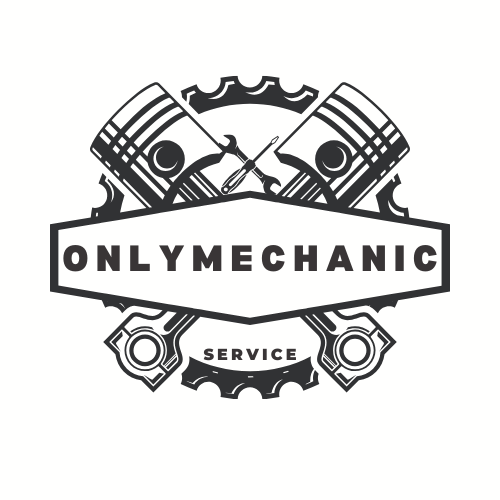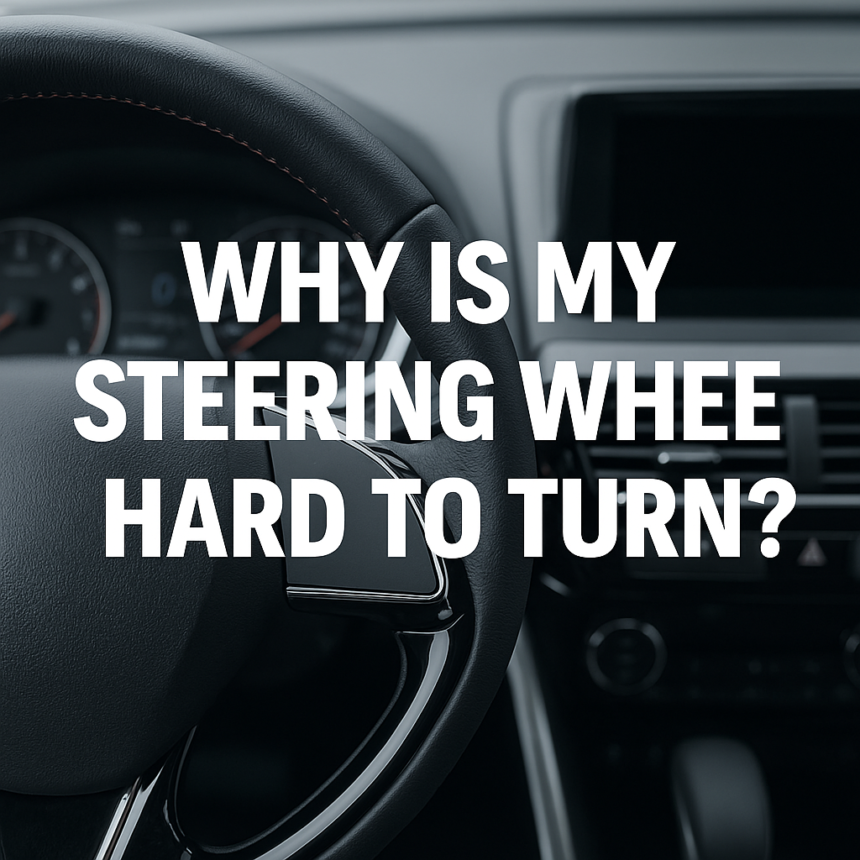Introduction
Turning your steering wheel should feel smooth and effortless—like gliding through a curve. But if you suddenly need to muscle your way through a simple turn, it’s a clear sign that something’s wrong. A hard-to-turn steering wheel isn’t just inconvenient—it’s dangerous.
This guide dives deep into the most common reasons your steering wheel becomes stiff, how to diagnose each issue like a pro mechanic, and what fixes or preventive steps you can take to restore full steering control. Whether you drive a modern car with electronic power steering or an older hydraulic system, this post will help you get to the bottom of the problem.
Table of Contents
- Top 9 Causes of Hard Steering
- Diagnostic Checklist
- Fixes and Repairs Explained
- Can You Drive with a Hard Steering Wheel?
- Maintenance Tips to Prevent Stiff Steering
- FAQs
- Key Takeaways
<a id= »causes »></a>
1. Top 9 Causes of a Hard Steering Wheel
1.1 Low Power Steering Fluid
The most common cause.
Hydraulic systems rely on fluid pressure to assist your input. A drop in fluid means less pressure and more effort to turn the wheel.
- Symptoms: Groaning or whining noises, fluid reservoir low or empty
- Fix: Top off fluid; if it drops again, inspect for leaks at hoses or the steering rack
1.2 Power Steering Pump Failure
If your fluid level is fine, the pump might not be generating pressure.
- Symptoms: Stiff steering at all speeds, squealing noises, pump whine
- Fix: Replace the pump; check drive belt condition too
1.3 Damaged Serpentine Belt
The serpentine belt drives the power steering pump. If it slips or breaks, the pump can’t do its job.
- Symptoms: Sudden steering stiffness, battery warning light, belt wear or cracks
- Fix: Replace the belt and inspect the tensioner pulley
1.4 Steering Rack or Gearbox Failure
The rack translates your steering input into lateral motion for the wheels. Internal damage or wear can cause binding.
- Symptoms: Very stiff steering, uneven stiffness, visible fluid leak around rack boots
- Fix: Replace or rebuild the steering rack
1.5 Contaminated or Old Power Steering Fluid
Dirty fluid loses viscosity and pressure stability, making the wheel harder to turn.
- Symptoms: Brown or black fluid, sticky or sluggish steering
- Fix: Flush and replace the power steering fluid
1.6 Tire Pressure Too Low
Underinflated tires increase resistance on the road, especially during low-speed turns.
- Symptoms: Heavy steering, uneven tire wear, low tire warning light
- Fix: Inflate tires to the recommended pressure found on the door sticker
1.7 Suspension or Steering Linkage Binding
If ball joints, tie rods, or bushings seize up, it affects steering effort.
- Symptoms: Popping or clunking noises, uneven tire wear, inconsistent turning force
- Fix: Lubricate or replace worn suspension/steering components
1.8 Electronic Power Steering (EPS) Fault
Modern cars use electric motors to assist steering. A failure in the system causes sudden stiffness.
- Symptoms: EPS warning light on dash, intermittent stiffness, fault codes stored
- Fix: Scan with a diagnostic tool and replace failed sensors or motors
1.9 Steering Column Obstruction or Damage
Sometimes, physical blockage or damage inside the column causes resistance.
- Symptoms: Grinding noises while turning, stiffness at a specific angle
- Fix: Remove column covers and inspect the universal joints or shaft bearings
<a id= »checklist »></a>
2. Quick Diagnostic Checklist

<a id= »fixes »></a>
3. Fixes and Repairs Explained
A. Top Off Power Steering Fluid
- Use the correct fluid type for your vehicle (ATF or dedicated PSF)
- Fill to the cold level on the dipstick
- Turn the wheel fully left and right to bleed air
B. Replace the Power Steering Pump
- Remove serpentine belt
- Disconnect pressure and return hoses
- Unbolt the pump, replace with new or rebuilt unit
- Refill and bleed system thoroughly
C. Serpentine Belt Replacement
- Use a belt routing diagram
- Release tensioner with a wrench
- Slip off old belt and install new one carefully
- Check alignment to prevent future slipping
D. Flush Power Steering System
- Siphon out old fluid
- Refill with fresh fluid
- Disconnect return hose, let old fluid exit while turning the wheel
- Reconnect and top off again
E. Inspect Suspension and Linkages
- Jack up front wheels and check for play
- Examine tie rods, control arm bushings, and ball joints
- Replace any seized or torn components
F. EPS Repair (For Electric Steering)
- Scan the ECU for codes (e.g., C102D, U3000)
- Replace failed steering torque sensors, EPS motors, or controllers
- Perform EPS reset or recalibration using scan tool
<a id= »safe »></a>
4. Can You Drive with a Hard Steering Wheel?
Short answer: Not recommended. Driving with a hard steering wheel puts your safety at risk, especially during emergency maneuvers.
| Situation | Safe to Drive? | Reason |
|---|---|---|
| Slight stiffness only at low speeds | Maybe short distances | Inflate tires or top off fluid ASAP |
| Sudden full steering loss | No | Risk of collision, especially at speed |
| EPS warning light + hard turns | No | System fault may worsen unpredictably |
| Known fluid leak under rack | No | Could result in total steering loss mid-drive |
Pro Tip: If you must drive, go slow, avoid tight corners, and head straight to a mechanic.
<a id= »maintenance »></a>
5. Maintenance Tips to Prevent Steering Issues
- Check power steering fluid every oil change
- Inspect the serpentine belt for wear every 6 months
- Rotate tires and check air pressure monthly
- Flush power steering system every 60,000 km
- Inspect suspension joints and bushings annually
- Use the correct type of fluid and parts for your steering system
- For EPS-equipped cars: avoid battery drains that can cause EPS calibration faults
<a id= »faqs »></a>
6. Frequently Asked Questions
Q1: Why is my steering wheel hard to turn when the car is cold?
Cold temperatures thicken power steering fluid, especially if it’s old or dirty. It can also indicate a failing pump.
Q2: Can low battery voltage affect steering?
Yes, especially in vehicles with EPS. Low voltage can cause the EPS system to disable or enter limp mode.
Q3: Can alignment cause hard steering?
Yes. Misalignment creates drag and uneven resistance in the suspension system, making steering feel stiff or pulling in one direction.
Q4: Why is it hard to turn only in one direction?
Usually a stuck steering rack, seized tie rod, or a damaged column u-joint. Have both sides of the system inspected.
Q5: Is it expensive to fix a stiff steering wheel?
It depends. A fluid top-up may cost less than $10. A steering rack or EPS motor could run into hundreds of dollars.
<a id= »summary »></a>
7. Key Takeaways
- A stiff steering wheel is usually caused by low fluid, a failed pump, or steering rack damage
- Modern EPS systems can fail electrically—watch for warning lights
- Don’t ignore the issue, especially if it gets worse while driving
- Regular maintenance and fluid checks are the best prevention
- If unsure, get a diagnostic scan and visual inspection from a trusted mechanic
Don’t Guess. Diagnose with Confidence.
Whether you’re maintaining your own car or helping customers at your garage, knowing the true cause behind hard steering can save time, money, and lives. For more expert tutorials and diagnostic guides, visit OnlyMechanic.com — your trusted source for everything mechanical.



You actually make it seem so easy with your presentation but I find this topic to be really something which I think I would never understand. It seems too complex and extremely broad for me. I’m looking forward for your next post, I’ll try to get the hang of it!
I am extremely inspired with your writing skills and also with the structure to your blog. Is this a paid topic or did you modify it yourself? Anyway stay up the nice high quality writing, it is uncommon to look a nice weblog like this one today..